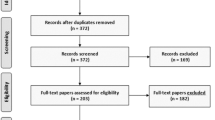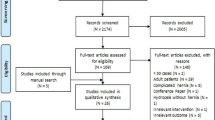Abstract
Purpose
To undertake a meta-analysis of comparative data of laparoscopic versus open inguinal herniotomy in infants and children.
Methods
We searched MEDLINE, EMBASE, and The Cochrane Central Controlled Trials Registry for relevant randomized controlled trials and observational studies comparing laparoscopic with open inguinal hernia repair in children aged less than 19 years.
Results
Data on 2,699 children were identified from 10 comparative studies. Laparoscopic techniques were associated with a trend towards higher recurrence rate (OR = 1.81; 95% CI 0.89–3.67; p = 0.10), longer operative time for unilateral repairs (WMD = 10.23; 95% CI 8.82–11.64; p < 0.00001), and may be shorter operative time for bilateral repairs (WMD = −4.54; 95% CI −11.63 to 2.55; p = 0.21). There was a significant reduction in developing a contralateral metachronous inguinal hernia in the laparoscopic group (OR = 0.37; 95% CI 0.20–0.67; p = 0.001).
Conclusions
Laparoscopic inguinal herniotomy is significantly associated with longer operative time for unilateral cases and a reduction in metachronous hernia development. There was a trend towards higher recurrence rate for laparoscopic repairs and shorter operative time for bilateral cases. A well conducted randomized controlled trial is warranted to compare both approaches.




Similar content being viewed by others
References
Kapur P, Caty MG, Glick PL (1998) Pediatric hernias and hydroceles. Pediatr Clin North Am 45:773–789
Levitt MA, Ferraraccio D, Arbesman MC, Brisseau GF, Caty MG, Glick PL (2002) Variability of inguinal hernia surgical technique: a survey of North American pediatric surgeons. J Pediatr Surg 37:745–751
Antonoff MB, Kreykes NS, Saltzman DA, Acton RD (2005) American academy of pediatrics section on surgery hernia survey revisited. J Pediatr Surg 40:1009–1014
Ein SH, Njere I, Ein A (2006) Six thousand three hundred sixty one pediatric inguinal hernias; a 35-year review. J Pediatr Surg 41:980–986
Schier F (1998) Laparoscopic herniorraphy in girls. J Pediatr Surg 33:1495–1497
Montupet P, Esposito C (1999) Laparoscopic treatment of congenital inguinal hernia in children. J Pediatr Surg 34:420–423
Haddad M, Kamal A (2000) Is ligation of the hernia sac necessary? J Pediatr Endosurg Innov Tech 4:77
Schier F (2000) Laparoscopic surgery of inguinal hernia in children—initial experience. J Pediatr Surg 35:1331–1338
Schier F, Montupet P, Esposito C (2002) Laparoscopic inguinal herniorraphy in children: a three-center experience with 933 repairs. J Pediatr Surg 37:395–397
Prasad R, Lovvorn HN III, Wadle GM, Lobe TE (2003) Early experience with needlescopic inguinal herniorraphy in children. J Pediatr Surg 38:1055–1058
Chan KL, Tam PKH (2003) A safe laparoscopic technique for the repair of inguinal hernias in boys. J Am Coll Surg 196:987–989
Chan KL, Tam PKH (2004) Technical refinements in laparoscopic repair of childhood inguinal hernia. Surg Endosc 18:957–960
Yip KF, Tam PK, Li MK (2004) Laparoscopic flip-flap hernioplasty: an innovative technique for pediatric hernia surgery. Surg Endosc 18:1126–1129
Jialin L, Hanxin Z, Xiaofang Y, Shiyun B (2007) Laparoscopic herniorraphy combined ligation of the hernial sac and suturation of the internal ring in children with indirect inguinal hernias. Surg Laparosc Endosc Percutan Tech 17:95–98
Chan KL, Chan HY, Tam PKH (2007) Towards a near-zero recurrence rate in laparoscopic inguinal hernia repair for pediatric patients of all ages. J Pediatr Surg 42:1993–1997
Laberge JM (2002) What’s new in pediatric surgery? J Am Coll Surg 195:208–218
Chan KL, Hui WC, Tam PKH (2005) Prospective, randomized, single-center, single-blind comparison of laparoscopic vs open repair of pediatric inguinal hernia. Surg Endosc 19:927–932
Wells GA, Shea B, O’Connell D, Peterson J, Welch V, Losos M, Tugwell P (2005) The Newcastle-Ottawa Scale (NOS) for assessing the quality of nonrandomised studies in meta-analyses. http://www.lri.ca/programs/ceu/oxford.htm
Niyogi A, Tahim AS, Sherwood WJ, De Caluwe D, Madden NP, Abel RM, Haddad MJ, Clarke S (2010) A comparative study examining open inguinal herniotomy with or without hernioscopy to laparoscopic inguinal hernia repair in a pediatric population. Pediatr Surg Int 26:387–392
Tsai YC, Wu CC, Yang SSD (2010) Open versus minilaparoscopic herniorrhaphy for children: a prospective comparative trial with midterm follow-up evaluation. Surg Endosc 24:21–24
Koivusalo AI, Korpela R, Wirtavuori K, Piiparinen S, Rintala RJ (2009) A single-blinded, randomized comparison of laparoscopic versus open hernia repair in children. Pediatrics 123:332–337
Endo M, Watanabe T, Nakano M, Yoshida F, Ukiyama E (2009) Laparoscopic completely extraperitoneal repair of inguinal hernia in children: a single-institute experience with 1,257 repairs compared with cut-down herniorrhaphy. Surg Endosc 23:1706–1712
Bharathi RS, Arora M, Baskaran V (2008) Congenital inguinal hernia: lap vs open surgery: how great is the difference? JSLS 12:277–281
Hassan ME, Mustafawi AR (2007) Laparoscopic flip-flap technique versus conventional inguinal hernia repair in children. JSLS 11:90–93
Koivusalo A, Pakarinen MP, Rintala RJ (2007) Laparoscopic herniorrhaphy after manual reduction of incarcerated inguinal hernia. Surg Endosc 21:2147–2149
Oue T, Kubota A, Okuyama H, Kawahara H (2005) Laparoscopic percutaneous extraperitoneal closure (LPEC) method for the exploration and treatment of inguinal hernia in girls. Pediatr Surg Int 21:964–968
Antao B, Samuel M, Curry J, Kiely E, Drake D (2004) Comparative evaluation of laparoscopic vs. open inguinal herniotomy in infants. Pediatr Endosurg Innov Tech 8:302–309
Bharathi RS, Arora M, Baskaran V (2008) Minimal access surgery of pediatric inguinal hernias: a review. Surg Endosc 22:1751–1762
Parelkar SV, Oak S, Gupta R, Sanghvi B, Shimoga PH, Kaltari D, Prakash A, Shekhar R, Gupta A, Bachani M (2010) Laparoscopic inguinal hernia repair in the pediatric age group- experience with 437 children. J Pediatr Surg 45:789–792
Ron O, Eaton S, Pierro A (2007) Systematic review of the risk of developing a metachronous contralateral inguinal hernia in children. BJS 94:804–811
Perlstein J, Du Bois J (2000) The role of laparoscopy in the management of suspected recurrent pediatric hernias. J Pediatr Surg 35:1205–1208
Esposito C, Montupet P (1998) Laparoscopic treatment of recurrent inguinal hernia in children. Pediatr Surg Int 14:182–184
Chan KL (2007) Laparoscopic repair of recurrent childhood inguinal hernias after open herniotomy. Hernia 11:37–40
Kaya M, Huckstadt T, Schier F (2006) Laparoscopic approach to incarcerated inguinal hernia in children. J Pediatr Surg 41:567–569
Shalaby R, Shams AM, Mohamed S, El-Leathy M, Ibrahem M, Alsaed G (2007) Two-trocar needlescopic approach to incarcerated inguinal hernia in children. J Pediatr Surg 42:1259–1262
Acknowledgments
I would like to thank Dr Khalid Alfaleh for his advice regarding some of the aspects of the methodology of this systematic review.
Author information
Authors and Affiliations
Corresponding author
Rights and permissions
About this article
Cite this article
Alzahem, A. Laparoscopic versus open inguinal herniotomy in infants and children: a meta-analysis. Pediatr Surg Int 27, 605–612 (2011). https://doi.org/10.1007/s00383-010-2840-x
Published:
Issue Date:
DOI: https://doi.org/10.1007/s00383-010-2840-x




